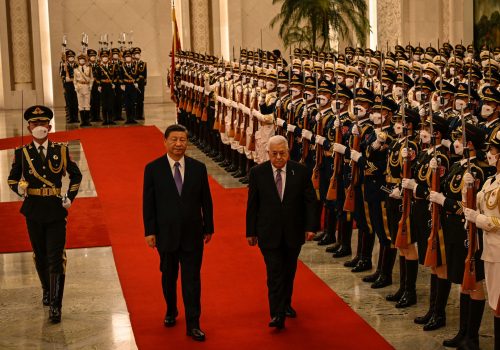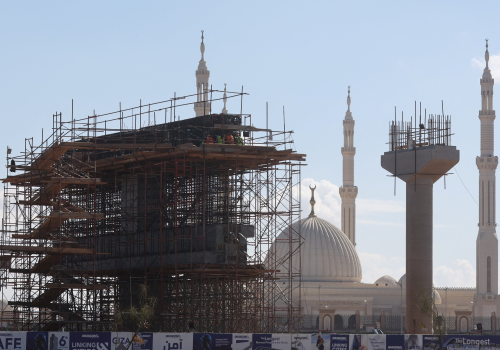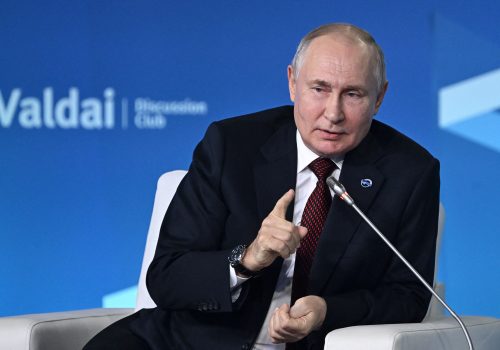What to look for as Putin and Xi meet at the Belt and Road Forum
“Tell me who your friend is, and I’ll tell you who you are.” When Russian President Vladimir Putin shared this adage with state-run China Media Group on Monday, just ahead of his trip to Beijing to meet with Chinese leader Xi Jinping, he seemed to intend it as a compliment to Xi and himself. But it’s the duo’s decidedly negative traits—an autocratic grip on power and a hostility toward the global order—that are the most apparent shared characteristics of their “no limits” friendship.
Putin and Xi are expected to meet during the October 17-18 Belt and Road Initiative (BRI) forum, which marks ten years since China’s landmark program launched. It comes after Xi visited Moscow in March and amid Russia’s ongoing and brutal war in Ukraine. Below, Atlantic Council experts share their insights on what to look for from the leaders and at the forum.
Click to jump to an expert analysis:
Gabriel “Gabo” Alvarado: New crises give Beijing an opportunity to blame the West
Niva Yau: The BRI is working—as a global information manipulation campaign
Joseph Webster: Will Beijing’s support of Russia in Ukraine continue to creep up?
Jeremy Mark: The BRI debt crisis is hitting full force
Niels Graham: The BRI forum is another chance for Russia to align its economy with China
New crises give Beijing an opportunity to blame the West
Xi and Putin will likely discuss the ongoing Israel-Hamas conflict if they meet on the margins of the BRI forum. Both will also likely reiterate previous remarks about the need for a ceasefire and a political solution to the conflict. On the latter, we can probably expect Beijing to include its various initiatives, namely the Global Development Initiative (GDI) and the Global Security Initiative (GSI)—along with BRI—in any subsequent statements around the forum. As seen in its approach to the war in Ukraine, Beijing is keen to sell the GDI and the GSI as better models for addressing the world’s problems. In reality, however, these initiatives are more about reshaping the global order to suit Beijing’s interests.
Put bluntly, new crises give Beijing an opportunity to blame the West for the current state of the world and promote its alternative vision for global governance—in essence, a system that governs more like, or at minimum accepts, how the Communist Party of China rules. That Beijing and Washington are at the same time paving the way for a Biden-Xi meeting in November in San Francisco does not change Beijing’s calculus.
—Gabriel “Gabo” Alvarado is a nonresident senior fellow in the Atlantic Council’s Global China Hub.
The BRI is working—as a global information manipulation campaign
The BRI is failing as a grand connectivity project, but it’s still an instrumental part of Beijing’s global information manipulation campaign in the Global South. So far, Beijing’s information strategy to boost positive narratives to crowd out and neutralize criticisms finds its foundation in the economic ties it has with the host country. These narratives are often grounded in language of the Belt and Road Initiative, exaggerating project contributions to local communities, including employing misleading figures of investment and promises of a bright future the BRI will bring to the host country, if it stays on the path of strong relations with Beijing.
Disseminated through local networks of Beijing-friendly media partners—while at the same time incentivizing local governments to restrict the space for independent journalists to freely report—this tactic has worked to weaken civil society in the Global South and the ability to monitor and hold Chinese projects accountable to local laws.
—Niva Yau is a nonresident fellow with the Atlantic Council’s Global China Hub.
Will Beijing’s support of Russia in Ukraine continue to creep up?
The Xi-Putin meeting could be a defining geopolitical moment, especially if the two sides agree to the Power of Siberia-2. The massive Russia-to-northern China natural gas pipeline would draw from basins that have traditionally supplied European demand, deepening Moscow’s pivot to the east—and its reliance on Beijing.
A major pipeline agreement between the two sides would have big geopolitical ramifications, especially as the economics of the pipeline appear highly unfavorable.
Of course, it’s also possible that the two sides will reach a smaller, more limited energy deal. This could, for example, include agreeing to more oil and liquefied natural gas cooperation or installing additional compressor stations on the existing Power of Siberia pipeline.
In any event, the meeting could reveal if Beijing will continue to escalate its pro-Russia “neutrality.” While the West has gradually and carefully increased its military support for Ukraine in the form of tanks, missiles, and fighter jets, Beijing has also doubled down on its support for Moscow. In addition to surging bilateral trade flows, Beijing has assiduously and progressively provided Moscow with dual-use goods, including trench-digging equipment, ball bearings, semiconductors, and more.
Beijing has provided “nonlethal” assistance to the Kremlin that has resulted in deadly consequences for Ukrainian forces. The Xi-Putin meeting this week may reveal if Beijing will continue to escalate its role in the conflict.
—Joseph Webster is a senior fellow at the Atlantic Council’s Global Energy Center, where he leads the center’s efforts on Chinese energy security, offshore wind, and hydrogen.
The BRI debt crisis is hitting full force
While Beijing will trumpet the BRI’s achievements at the tenth anniversary gathering, behind the bluster it will be working hard to address the indebtedness that has accompanied the infrastructure projects. Efforts to restructure this debt—which totals hundreds of billions of dollars—have been slowed by China’s unwillingness to participate in multilateral negotiations in several countries. Instead, it has preferred to proceed on a bilateral basis, as in the preliminary agreement that its Export-Import Bank is reported to have reached with Sri Lanka last month.
China’s BRI conferences focused on the debt issue as early as 2019, when then International Monetary Fund Managing Director Christine Lagarde—in Xi’s presence—declared that “history has taught us that, if not managed carefully, infrastructure investments can lead to a problematic increase in debt.” Since that time, what has changed is that China has cut back its new lending, but the debt crisis has hit full force. And while Beijing has received cautious praise for its willingness earlier this year to join a preliminary restructuring agreement with Zambia, it continues to place speed bumps in the way of efforts to resolve the debt crisis in many other countries.
—Jeremy Mark is a nonresident senior fellow at the Atlantic Council’s GeoEconomics Center and a specialist in political, economic, and financial issues related to Asia and Africa.
The BRI forum is another chance for Russia to align its economy with China
The collapse of Russian car manufacturing exemplifies the powerful impact Western sanctions and export controls have had on the Russian economy. Its slow rebirth epitomizes the new influence China is gaining over it. Western sanctions halted the domestic production of Russian cars. After a period of painful adjustment in which prices surged and sales collapsed by nearly 60 percent, Moscow was able to secure new imports from China. The next step, which Russian President Vladimir Putin will likely further during his visit to China this week, will be to convince new Chinese manufacturers to restore production within Russia’s own borders.
Western restrictions, in conjunction with an exodus of their companies, forced the shutdown eighteen of Russia’s twenty automobile manufacturing plants. To stabilize its domestic car market, Moscow turned to Beijing. Chinese car exports surged five-fold. As of June 2023, imported Chinese cars accounted for 49 percent of Russia’s market compared with a pre-war share of just 7 percent in June 2021. With the market stable, the Kremlin now hopes to bring its own idle plants back online. For that, it will need to replace blocked Western components and know-how with new Chinese joint-ventures.
This transaction has already begun. Shortly after the impact of Western controls became clear, Moscow announced the relaunch of a Soviet-era car manufacturer, the Moskvich. In November, production resumed at a nationalized plant formerly owned by the French car manufacturer Renault. Critical to this was a partnership with China’s JAC Motors which supplied the design, engineering, and production platform. Moscow is now hoping to replicate this partnership to resume production across a number of other automobile manufacturing plants. Without Western collaboration, it will need new joint-ventures if it hopes to go from the around 800,000 cars the government expects to produce this year to its prewar average of 1.3 million. A warm meeting between Putin and Chinese leader Xi Jinping exploring new ways to link their respective economies, could support this.
These efforts are not without risks. While China is happy to export goods to the Russian consumer market, it seems reluctant to invest in the heavily sanctioned, high-risk market. For Russia, Chinese support may allow it to resume domestic production more quickly but also further entrenches its economy to its much larger southern neighbor, giving Beijing immense sway over its future economic prospects.
—Niels Graham is an associate director for the Atlantic Council GeoEconomics Center.
Further reading
Wed, Jun 21, 2023
How Beijing’s newest global initiatives seek to remake the world order
Issue Brief By Michael Schuman, Jonathan Fulton, Tuvia Gering
Recommendations on how US policymakers and European and Indo-Pacific partners can better understand China’s latest development and security initiatives to meet the rising competition.
Mon, Oct 16, 2023
Why China won’t win the Global South
Report By Michael Schuman
Beijing has devoted ample resources to garnering support from the Global South, but China’s ambitions to lead the developing world are facing challenges.
Thu, Oct 12, 2023
The West must learn hard lessons from years of failed Russia policies
UkraineAlert By
If Russia is able to achieve even a partial victory in Ukraine, the consequences for global security would be catastrophic. Western leaders must escalate their support for Ukraine to prevent this outcome and make sure Putin’s invasion ends in decisive defeat, writes Kira Rudik.
Image: Russian President Vladimir Putin and Chinese President Xi Jinping attend a welcome ceremony before Russia - China talks in narrow format at the Kremlin in Moscow, Russia March 21, 2023. Sputnik/Alexei Maishev/Kremlin


